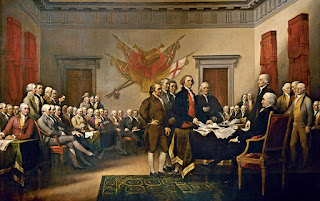The Battle of Gettysburg
The Battle of Gettysburg, fought from July 1 to July 3, 1863, is widely regarded as a turning point in the American Civil War. It was the largest battle ever fought in North America, involving around 85,000 men in the Union Army of the Potomac under Major General George G. Meade and approximately 75,000 in the Confederate Army of Northern Virginia commanded by General Robert E. Lee. The battle resulted in a significant Union victory that halted Lee's invasion of the North and marked the beginning of the Confederacy's decline.
Context and Prelude
In the summer of 1863, General Lee sought to capitalize on his recent victories and shift the war's focus from the ravaged South to the North. By invading Pennsylvania, Lee aimed to relieve pressure on Virginia's farmland, gather supplies, and influence Northern politicians to consider peace negotiations.
On June 28, 1863, President Abraham Lincoln appointed Major General George Meade as commander of the Army of the Potomac, replacing Major General Joseph Hooker. Meade, who was relatively unknown, quickly moved his forces northward to intercept Lee.
Day 1: July 1, 1863
The battle began on the morning of July 1, when advance units of the two armies unexpectedly collided at Gettysburg, a small town in southern Pennsylvania. Confederate forces, led by Major General Henry Heth, encountered Union cavalry under Brigadier General John Buford west of the town. Buford's men held their ground until Union infantry under Major General John F. Reynolds arrived to reinforce them.
Despite initial success, Reynolds was killed early in the fighting. By afternoon, Confederate reinforcements, including troops under Generals Richard S. Ewell and A.P. Hill, overwhelmed the Union forces, forcing them to retreat through the town to high ground south of Gettysburg, notably Cemetery Hill and Culp's Hill.
Day 2: July 2, 1863
Lee, confident from his successes on the first day, decided to attack the Union flanks. He ordered Lieutenant General James Longstreet to assault the left flank at the southern end of Cemetery Ridge. Meanwhile, Ewell was tasked with attacking the Union right on Culp's Hill.
Longstreet's attack, delayed until late afternoon, focused on key positions such as the Wheatfield, Devil's Den, and the Round Tops. The fighting was brutal and intense. Union Colonel Joshua L. Chamberlain's 20th Maine Regiment famously defended Little Round Top, a strategic hill, with a daring downhill bayonet charge, preventing the Confederates from flanking the Union line.
On the Union right, Ewell's men launched attacks on Culp's Hill and East Cemetery Hill but failed to secure these positions by nightfall. The Union forces held firm despite the Confederate onslaught, with heavy casualties on both sides.
Day 3: July 3, 1863
Lee, undeterred by the previous day's limited successes, decided on a bold plan: a direct assault on the center of the Union line on Cemetery Ridge. This attack, known as Pickett's Charge, involved approximately 12,500 Confederate soldiers advancing across open fields for three-quarters of a mile under heavy Union artillery and rifle fire.
The charge, led by Major General George Pickett, was a catastrophic failure. Union artillery and infantry decimated the Confederate ranks, and those who reached the Union line were quickly repulsed in fierce hand-to-hand combat. The Confederates suffered massive casualties, with more than half of the men involved in the charge killed, wounded, or captured.
Aftermath and Significance
The Battle of Gettysburg resulted in about 51,000 casualties, making it the bloodiest battle of the American Civil War. Union casualties numbered approximately 23,000 (3,100 killed, 14,500 wounded, 5,400 missing), while Confederate casualties were about 28,000 (4,700 killed, 12,800 wounded, 11,100 missing).
On the evening of July 4, with his army battered and demoralized, Lee began a retreat to Virginia. Meade, criticized later for not aggressively pursuing the retreating Confederates, chose to consolidate his victory and tend to the wounded.
Gettysburg was a turning point for several reasons:
1. Strategic Victory:Lee's defeat ended his invasion of the North and dashed hopes for Confederate recognition by European powers.
2. Psychological Impact: The victory boosted Northern morale and reaffirmed the Union's resolve to continue the fight.
3. Political Consequences: It gave President Lincoln the momentum he needed to deliver the Gettysburg Address later that year, which redefined the purpose of the war and galvanized public support.
4. Military Impact: The Confederate army was significantly weakened, suffering irreplaceable losses in men and morale, while the Union army gained confidence and momentum.
The Gettysburg Address
In November 1863, President Lincoln visited Gettysburg to dedicate the Soldiers' National Cemetery. His brief but profound Gettysburg Address eloquently expressed the war's purpose, honoring the fallen and redefining the conflict as a struggle not only for the Union but for the principle of human equality.
Conclusion
The Battle of Gettysburg stands as a crucial moment in American history, representing both a decisive military victory and a significant moral turning point in the Civil War. Its outcome, coupled with the Union victory at Vicksburg on July 4, 1863, marked the beginning of the end for the Confederacy. The battle's legacy endures, symbolizing the immense sacrifices made and the enduring fight for a united and free nation.
.jpg)
.jpg)


Comments
Post a Comment